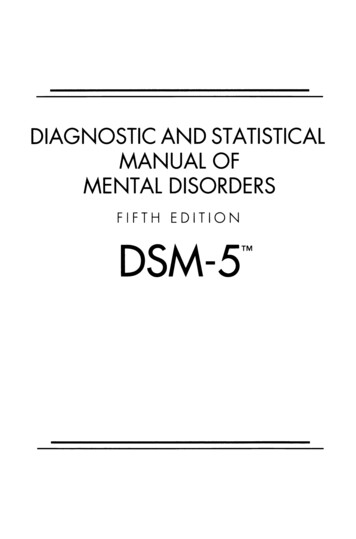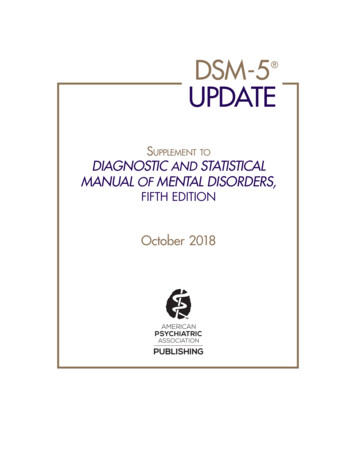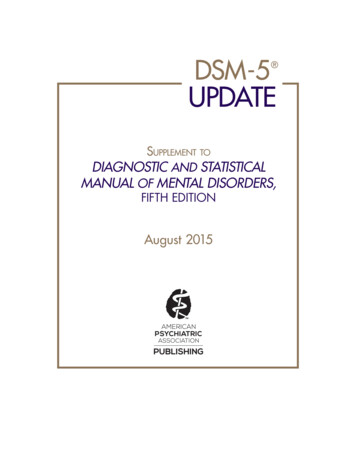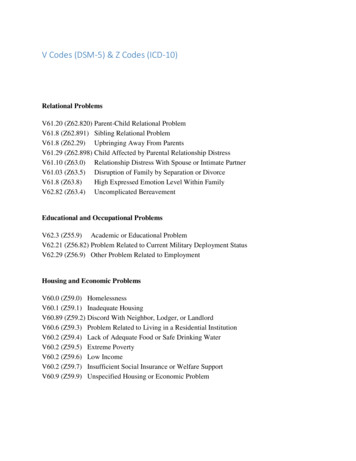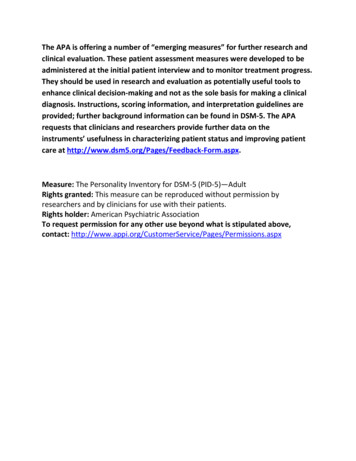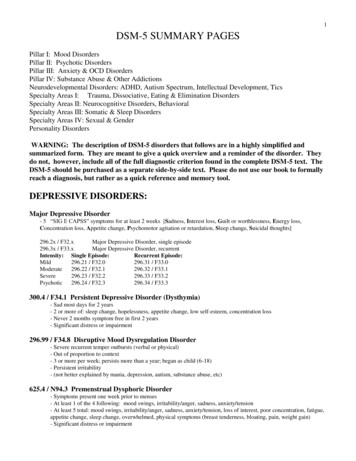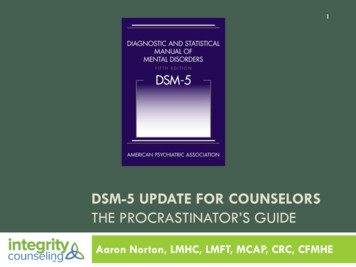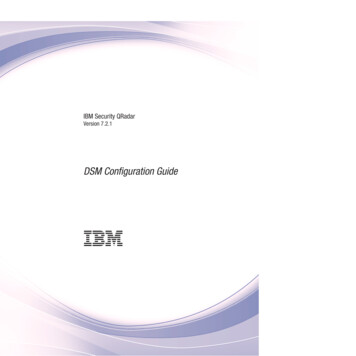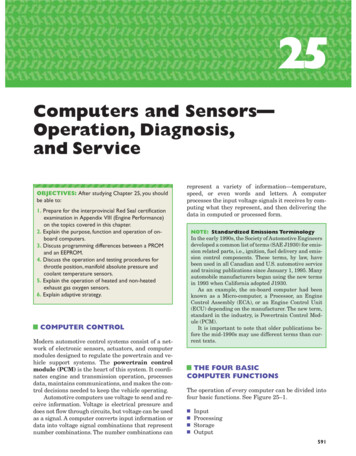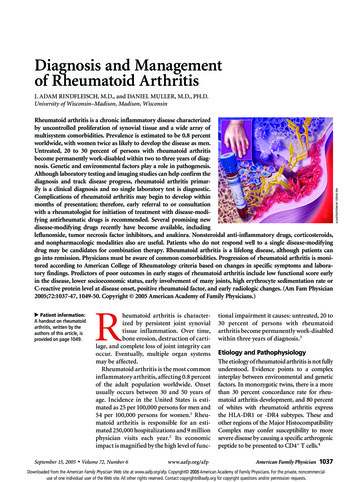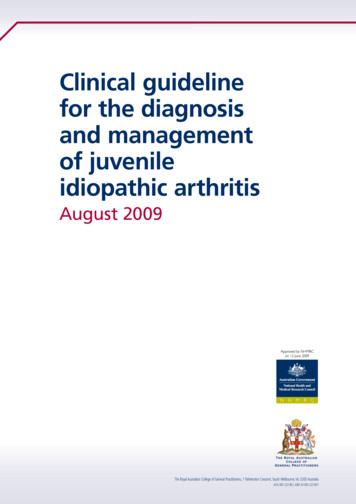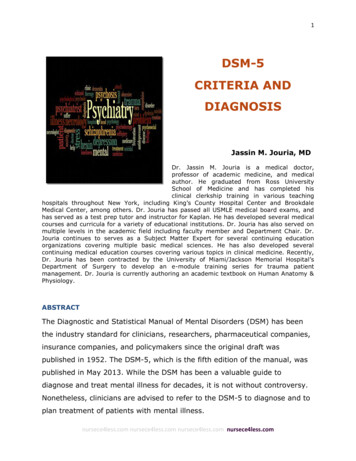
Transcription
1DSM-5CRITERIA ANDDIAGNOSISJassin M. Jouria, MDDr. Jassin M. Jouria is a medical doctor,professor of academic medicine, and medicalauthor. He graduated from Ross UniversitySchool of Medicine and has completed hisclinical clerkship training in various teachinghospitals throughout New York, including King’s County Hospital Center and BrookdaleMedical Center, among others. Dr. Jouria has passed all USMLE medical board exams, andhas served as a test prep tutor and instructor for Kaplan. He has developed several medicalcourses and curricula for a variety of educational institutions. Dr. Jouria has also served onmultiple levels in the academic field including faculty member and Department Chair. Dr.Jouria continues to serves as a Subject Matter Expert for several continuing educationorganizations covering multiple basic medical sciences. He has also developed severalcontinuing medical education courses covering various topics in clinical medicine. Recently,Dr. Jouria has been contracted by the University of Miami/Jackson Memorial Hospital’sDepartment of Surgery to develop an e-module training series for trauma patientmanagement. Dr. Jouria is currently authoring an academic textbook on Human Anatomy &Physiology.ABSTRACTThe Diagnostic and Statistical Manual of Mental Disorders (DSM) has beenthe industry standard for clinicians, researchers, pharmaceutical companies,insurance companies, and policymakers since the original draft waspublished in 1952. The DSM-5, which is the fifth edition of the manual, waspublished in May 2013. While the DSM has been a valuable guide todiagnose and treat mental illness for decades, it is not without controversy.Nonetheless, clinicians are advised to refer to the DSM-5 to diagnose and toplan treatment of patients with mental illness.nursece4less.com nursece4less.com nursece4less.com nursece4less.com
2Continuing Nursing Education Course PlannersWilliam A. Cook, PhD, Director, Douglas Lawrence, MA, Webmaster,Susan DePasquale, MSN, FPMHNP-BC, Lead Nurse PlannerPolicy StatementThis activity has been planned and implemented in accordance with thepolicies of NurseCe4Less.com and the continuing nursing educationrequirements of the American Nurses Credentialing Center's Commission onAccreditation for registered nurses. It is the policy of NurseCe4Less.com toensure objectivity, transparency, and best practice in clinical education forall continuing nursing education (CNE) activities.Continuing Education Credit DesignationThis educational activity is credited for 5.5 hours. Nurses may only claimcredit commensurate with the credit awarded for completion of this courseactivity.Statement of Learning NeedThe DSM-5 takes a different approach in several broad categories todiagnose mental disorders. Critics of newer versions of the DSM argue morescientific methods are needed to diagnose mental health conditions. Use ofthe DSM-5 requires clinicians to be aware of the latest changes and need forfuture research to improve psychiatric diagnosis and treatment.nursece4less.com nursece4less.com nursece4less.com nursece4less.com
3Course PurposeTo provide professional nurses with knowledge of the DSM-5 for psychiatricdiagnosis and treatment.Target AudienceAdvanced Practice Registered Nurses and Registered Nurses(Interdisciplinary Health Team Members, including Vocational Nurses andMedical Assistants may obtain a Certificate of Completion)Course Author & Planning Team Conflict of Interest DisclosuresJassin M. Jouria, MD, William S. Cook, PhD, Douglas Lawrence, MASusan DePasquale, MSN, FPMHNP-BC – all have no disclosuresAcknowledgement of Commercial SupportThere is no commercial support for this course.Activity Review InformationReviewed by Susan DePasquale, MSN, FPMHNP-BCRelease Date: 7/14/2016Termination Date: 7/14/2017Please take time to complete a self-assessment of knowledge, onpage 4, sample questions before reading the article.Opportunity to complete a self-assessment of knowledge learnedwill be provided at the end of the course.nursece4less.com nursece4less.com nursece4less.com nursece4less.com
41. According to the American Psychiatric Association (“APA”), thepurpose of the DSM wasa. to serve as an educational tool for teaching psychopathology.b. to provide a helpful guide to clinical practice.c. facilitate research and improve communication among clinicians andresearchers.d. All of the above2. It was the that truly established the manual as thestandard for identifying and diagnosing mental disorders.a.b.c.d.DSM-IDSM-III-RDSM-IIIDSM-II3. A new section in the DSM-5 includes the role ofin diagnosing mental illness.a.b.c.d.behavior disorders of childhoodculturedementiagender4. Some conditions listed in DSM-5 for further study are:a. Persistent Complex Bereavement Disorderb. Internet Gaming Disorderc. Neurobehavioral Disorder Associated With Prenatal AlcoholExposured. All of the above5. True or False: The section on personality disorders changedsignificantly in the DSM-5 because of a new model to classifypersonality disorders.a. Trueb. Falsenursece4less.com nursece4less.com nursece4less.com nursece4less.com
5IntroductionThe American Psychiatric Association’s (APA) publication of the Diagnosticand Statistical Manual of Mental Disorders (DSM) has been the industrystandard for clinicians, researchers, pharmaceutical companies, insurancecompanies, and policymakers since the original draft was published in 1952.1The fifth revision of the DSM manual, DSM-5, was published on May 22,2013, after receiving approval at the annual APA conference. Although themanual has been considered the standard for the diagnosis of mentaldisorders, each revision has been met with criticism due to the changes indiagnostic categories and the removal or inclusion of specific disorders.2The publication of the DSM-5 has been controversial and has received agreat deal of criticism throughout the entire revision process. Concernregarding proposed changes to specific disorders, along with the inclusion ofthose that many argue are not truly mental disorders, led to negative pressand direct appeals to the APA to seriously consider the impact the revisionswould have in the identification and diagnosis of mental disorders.3 Thiscourse will offer an overview of the new DSM-5, with emphasis placed on themanual’s changes and transitions from the DSM 4th edition.DSM-5: Historical Trends And DevelopmentRevisions to the DSM-5 began in 1999. Over the past years, a number oftask forces and working groups were established to examine current trendsin mental health and utilize research findings to make the appropriaterevisions to the diagnostic categories. Throughout the process, the APAsolicited feedback from experts in the field of mental health and ensuredthat each discipline and diagnostic category was represented. Once theworking groups established focused-work criteria, the manual was used innursece4less.com nursece4less.com nursece4less.com nursece4less.com
6field tests at select hospitals and clinics and data received from those trialswere used to modify the criteria.4 During the revision process, there wasmuch speculation about which disorders would be included in the new editionof the manual, and the availability of information spurred controversy asvarious groups and individuals began to weigh in on the potential changes.3When the DSM-5 was released many groups had already denounced themanual due to concern about the reliability and validity of the manual. Infact, these concerns have prompted the National Institute of Mental Healthto develop an alternate framework for diagnosis and treatment.5 How thesetwo standards will co-exist remains to be seen. This course will offer ageneral overview of the DSM-5, and emphasis is placed on the manual’schanges and transitions from the 4th edition.American Psychiatric AssociationThe American Psychiatric Association (APA) was founded in 1844 and servesas the world’s largest psychiatric organization. The APA is comprised of morethan 33,000 psychiatric physicians from the United States and worldwide.The mission of the APA is to carry forward the following values and servicesto the public. Promote the highest quality care for individuals with mental disorders(including intellectual disabilities and substance use disorders) and theirfamilies. Promote psychiatric education and research. Advance and represent the profession of psychiatry. Serve the professional needs of its membership.nursece4less.com nursece4less.com nursece4less.com nursece4less.com
7The APA serves psychiatrists throughout the world through a variety ofmechanisms. The four areas of focus are outlined below:61. Education and Training2. Publications3. Research4. Charitable contributions and public educationEducation and TrainingA primary goal of the APA is to provide education, training and careerdevelopment opportunities for psychiatrists and other physicians. The APA isaccredited through the Accreditation Council for Continuing MedicalEducation and is recognized as a leader in educational training. Educationalopportunities are diverse to meet the varying needs of the constituents andinclude annual scientific meetings, online training, published journals andother publications, and other relevant offerings. The goal is to meet theprofessional development needs of psychiatrists and physicians worldwideand assist with professional performance improvement through the variousinitiatives and offerings. In addition to psychiatrists and other physicians,educational support is provided to psychiatric educators, residents andmedical students and other health associates, such as therapists and nurses.Along with regular educational offerings, the APA also offers two educationalconferences each year: the APA Annual Meeting and the Institute onPsychiatric Services (IPS). The conferences provide an opportunity forindividuals to learn about new research and advances related to patient carestrategies and treatment options.6PublicationsAn important aspect of the American Psychiatric Association is the numerouspublications the organization produces each year. In fact, the APA isnursece4less.com nursece4less.com nursece4less.com nursece4less.com
8considered the world’s premier publisher of books, multimedia, and journalson psychiatry, mental health and behavioral science. Utilizing the expertiseof a broad network of mental health professionals, the APA produces avariety of publications that provide up-to-date information for mental healthprofessionals. The APA is most known for the Diagnostic and StatisticalManual of Mental Disorders (DSM), which is used as the standard fordiagnosis of psychiatric conditions. In addition to the DSM, the APA alsoproduces a number of journals, including the American Journal of Psychiatry,as well as numerous papers relevant to psychiatric care and a bimonthlynewspaper, Psychiatric News.6ResearchThe APA is one of the leading psychiatric research organizations in the world.The goal of research is to improve the quality of psychiatric care and expandthe knowledge base of mental health professionals. Specific researchprograms include the Practice Research Network, clinical and health servicesresearch, producing evidence-based practice guidelines, and oversight ofdevelopment of the Diagnostic and Statistical Manual of Mental Disorders(DSM). Research is also used to develop educational programs thatdisseminate new and emerging research findings and to help translate thosefindings into clinical practice.6Charitable Contributions and Public EducationThe APA is committed to advancing public understanding of mental healthissues and the need to effectively treat them. To accomplish this, the APAcreated the American Psychiatric Foundation (APF), which is the charitableand educational affiliate of the APA. The goal of APF is to promote awarenessof mental health and the effectiveness of treatment, the importance of earlynursece4less.com nursece4less.com nursece4less.com nursece4less.com
9intervention and access to care through grants, programs, research andawards.7PurposeThe Diagnostic and Statistical Manual of Mental Disorders (DSM) is used byhealthcare professionals throughout the world as a guide for the recognitionand diagnosis of mental disorders. The DSM provides a comprehensive list ofidentified mental disorders by classification category and includes adescription and symptoms, as well as clearly established criteria for thediagnosis of each disorder. The DSM also includes numerical codes for eachdisorder to assist with effective medical coding and record keeping.1 TheDSM is considered by practitioners in the mental health field to be theauthoritative guide to mental health disorders. According to the AmericanPsychiatric Association, the purpose of the DSM is:8 To provide a helpful guide to clinical practice. To facilitate research and improve communication among cliniciansand researchers. To serve as an educational tool for teaching psychopathology.The DSM is intended to assess and diagnose mental disorders. It does notinclude guidelines for the treatment of identified disorders.9 However, theDSM is a valuable asset in the treatment of patients as it provides the firststep of treatment, which is proper identification. In addition, the DSM helpsmeasure the effectiveness of treatment as initial diagnosis requires thepractitioner to carefully assess and determine the severity of the symptoms.This baseline data is helpful in assessing response to treatment, as longterm monitoring will include assessments of changes in severity ofsymptoms.1nursece4less.com nursece4less.com nursece4less.com nursece4less.com
10HistoryThe DSM-5 has an extensive history that dates back to the period before thepublication of the initial edition of the DSM-I in 1952. Prior to the publicationof the DSM, there was no standard system to identify and diagnose mentaldisorders. The creation of the DSM provided a consistent means forpractitioners to
Continuing Nursing Education Course Planners William A. Cook, PhD, Director, Douglas Lawrence, MA, Webmaster, . diagnosis of each disorder. The DSM also includes numerical codes for each disorder to assist with effective medical coding and record keeping.1 The DSM is considered by practitioners in the mental health field to be the authoritative guide to mental health disorders. According to .

